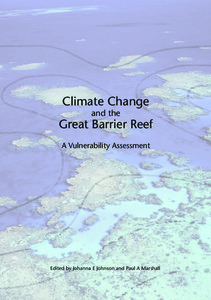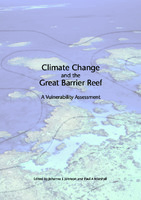Please use this identifier to cite or link to this item:
https://hdl.handle.net/11017/3033

| Title: | Chapter 0 (Intro): Climate change and the Great Barrier Reef: a vulnerability assessment |
| metadata.dc.subject.asfa: | Climate Vulnerability Ecosystem stability Barrier reefs |
| APAIS Subject: | Environmental impact Ecology |
| metadata.dc.subject.location: | Reef-wide |
| metadata.dc.subject.category: | Ecosystems Climate change |
| Year of publication: | 2007 |
| Publisher: | Great Barrier Reef Marine Park Authority |
| Series/Report no.: | Book: Climate change and the Great Barrier Reef: a vulnerability assessment |
| Abstract: | The Great Barrier Reef is one of the truly majestic places on our planet. Its size and brilliance make is observable even from space. Few ocean areas are known as well globally as the 2,300 km of reefs that extend over the Australian east coast. Comprised of more than 2,900 individual reefs that form its foundation, the Great Barrier Reef World Heritage Area encompasses a diversity of habitats, plants and animals of outstanding universal value. Scattered throughout its footprint are islands, mangroves and marine life of infinite variety. Like the Galapagos, the Great Barrier Reef has singular characteristics found nowhere else on Earth But, all of this is under threat as never before. Global climate change is a virtual sword of Damocles hanging over the very heart of the Great Barrier Reef. History reveals that reefs have been faced with changes in the past, including fluctuations in water temperature, sea level and acidification. Climate change has accelerated this rate of change, coinciding with mounting pressure from human uses. These threats are certainly not unique to the Great Barrier Reef. Around the world, coral reefs are faced with impacts from poor water quality, overfishing, physical damage and climate change. Experts estimate that 20 percent of the world’s coral reefs have been effectively destroyed and show no prospect of recovery, another 24 percent are under imminent risk of collapse through human pressures and 26 percent more are under longer term threat. What makes the Great Barrier Reef unique is that, so far, it has remained in relatively good condition compared to other reefs around the world. |
| URI: | https://hdl.handle.net/11017/3033 |
| Type of document: | Book |
| Appears in Collections: | Effects |
Files in This Item:
| File | Description | Size | Format | |
|---|---|---|---|---|
| Johnson_Marshall_2007_Climate_change_and_the_GBR_A_vulnerability_assessment.pdf | Complete book | 1.13 MB | PDF version |  View/Open |
Items in ELibrary are protected by copyright, with all rights reserved, unless otherwise indicated.
